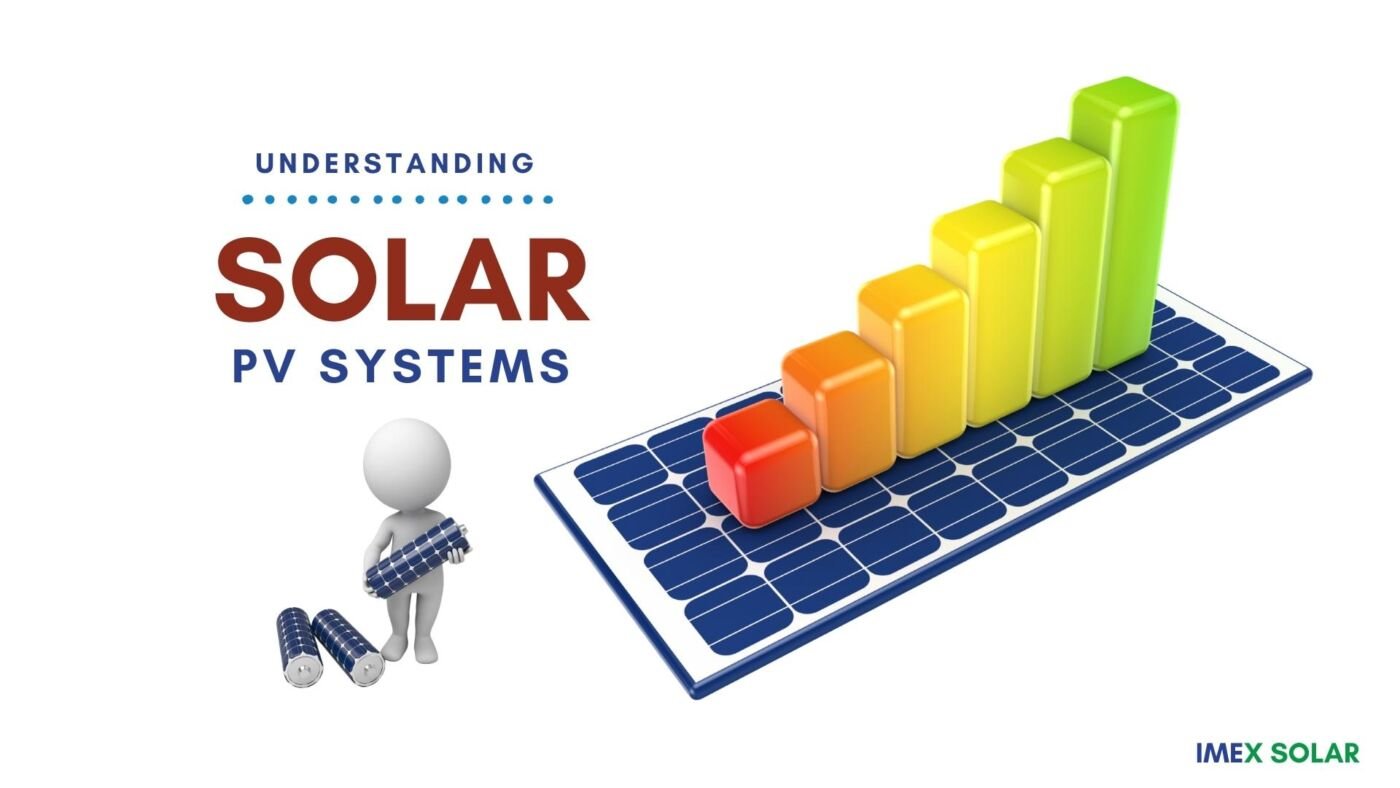Resources
The Basics of Solar PV Systems: Understanding Solar Panels and Inverters
“Solar inverters are the backbone of any solar power system, converting DC electricity into AC electricity that can be used by homes and businesses.”
Are you thinking about installing solar panels for your home or business but don’t know where to start?
Solar photovoltaic (PV) systems are becoming increasingly popular to generate electricity for homes, businesses, and communities. They use sunlight to produce electricity, making them an excellent source of renewable energy.
However, before investing in a solar PV system, it is essential to understand how it works and the components that make it up. In this blog, we will provide an overview of solar PV systems, explain how solar panels and inverters work, discuss some of the benefits of using solar PV systems and FAQs.
What are Solar PV Systems?
Solar PV systems, or solar photovoltaic systems, are a type of renewable energy system that converts sunlight into electricity using solar panels.
A solar PV system consists of several components, including solar panels, an inverter, and sometimes batteries for energy storage. Solar panels are made up of photovoltaic cells, which collect sunlight and convert it into direct current, DC electricity. The inverter then turns the direct current (DC) electricity into alternating current (AC) electricity, which can be utilized to power homes and businesses.
Solar panels can be installed on rooftops, ground-mounted, or integrated into building materials such as walls or windows. Solar Inverters are usually mounted on wall or structures and batteries are installed indoors.
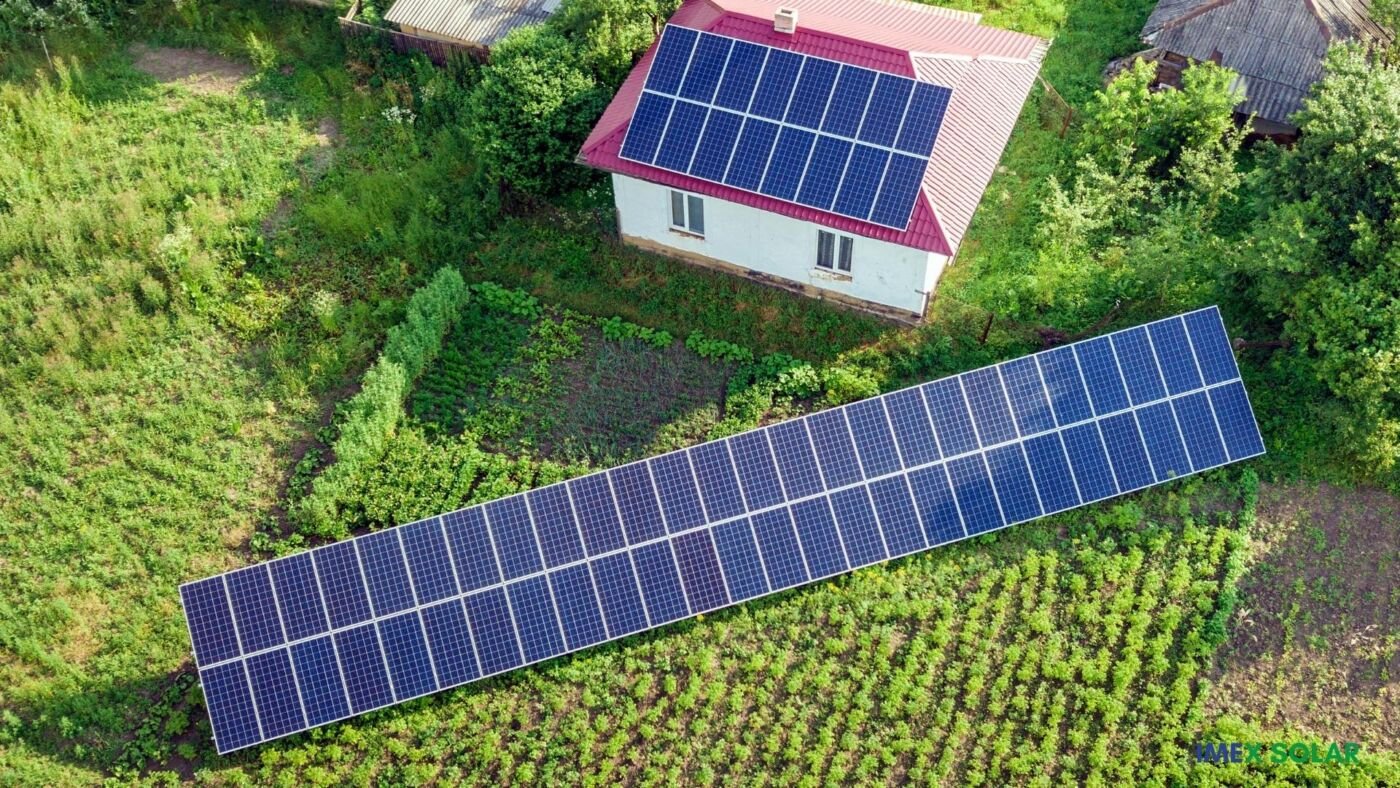
Types of Solar PV Systems
Based on application, solar PV systems mainly categorized as grid-tied (on grid), meaning they are connected to the local power grid, or off-grid, meaning they do not export power to the grid and store energy in batteries, while feeding the load.
There’s the latest trend, on-grid hybrid solar PV system, which is a type of solar power system that is designed to combine benefits of both grid tied and off grid solar systems, such they can export excess power to the grid as well as function as off grid system during grid power outages.
On Grid Solar Systems
On-grid solar PV systems, also known as grid-tied or grid-connected systems, are one of the most common types of solar power systems used today. These systems are designed to work in conjunction with the existing power grid, allowing homeowners and businesses to generate their own electricity while remaining connected to the utility grid.
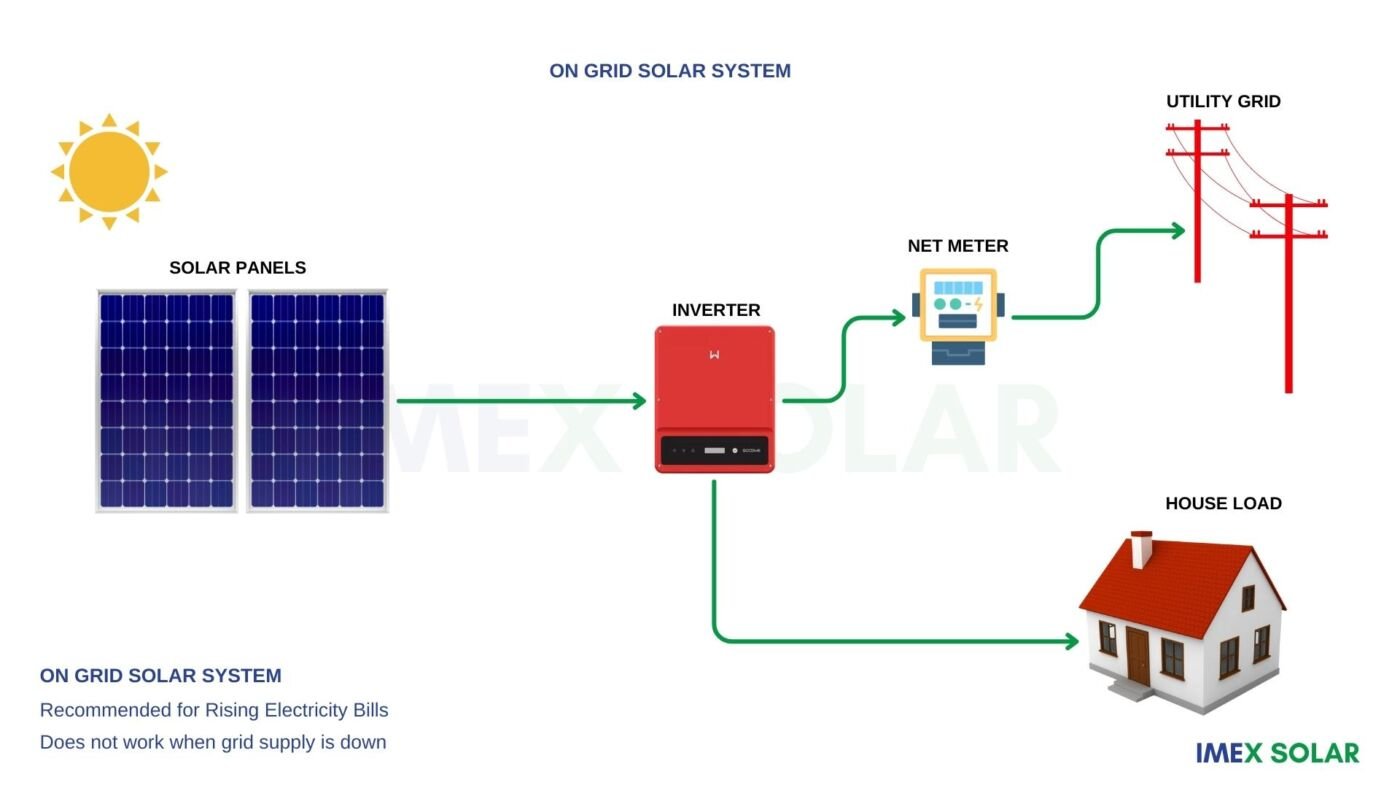
On grid solar systems are connected to the utility grid. This means that they generate electricity when the sun is shining and feed any excess power back into the grid. When the sun isn’t shining or the system isn’t generating enough power to meet the demand, the system can draw power from the grid to meet the needs of the home or business.
One of the main benefits of an on-grid solar PV system is the ability to generate your own electricity and reduce your reliance on the utility company. This can lead to lower electricity bills and provide a hedge against future rate increases. Additionally, on-grid systems are generally less expensive to install and maintain than off-grid systems, as they don’t require expensive batteries to store excess electricity.
However, a reliable grid supply is a must for on grid systems as they don’t function during grid power outages. This is considered as the major drawback of grid tied solar systems also main concern in decision making process.
Off Grid Solar PV Systems
Off-grid solar PV system operates independently of the utility grid. These systems are typically used in remote areas where grid supply is unstable. Off grid systems include solar panels, batteries to store excess energy, charge controllers, and an inverter to convert DC electricity to AC electricity.
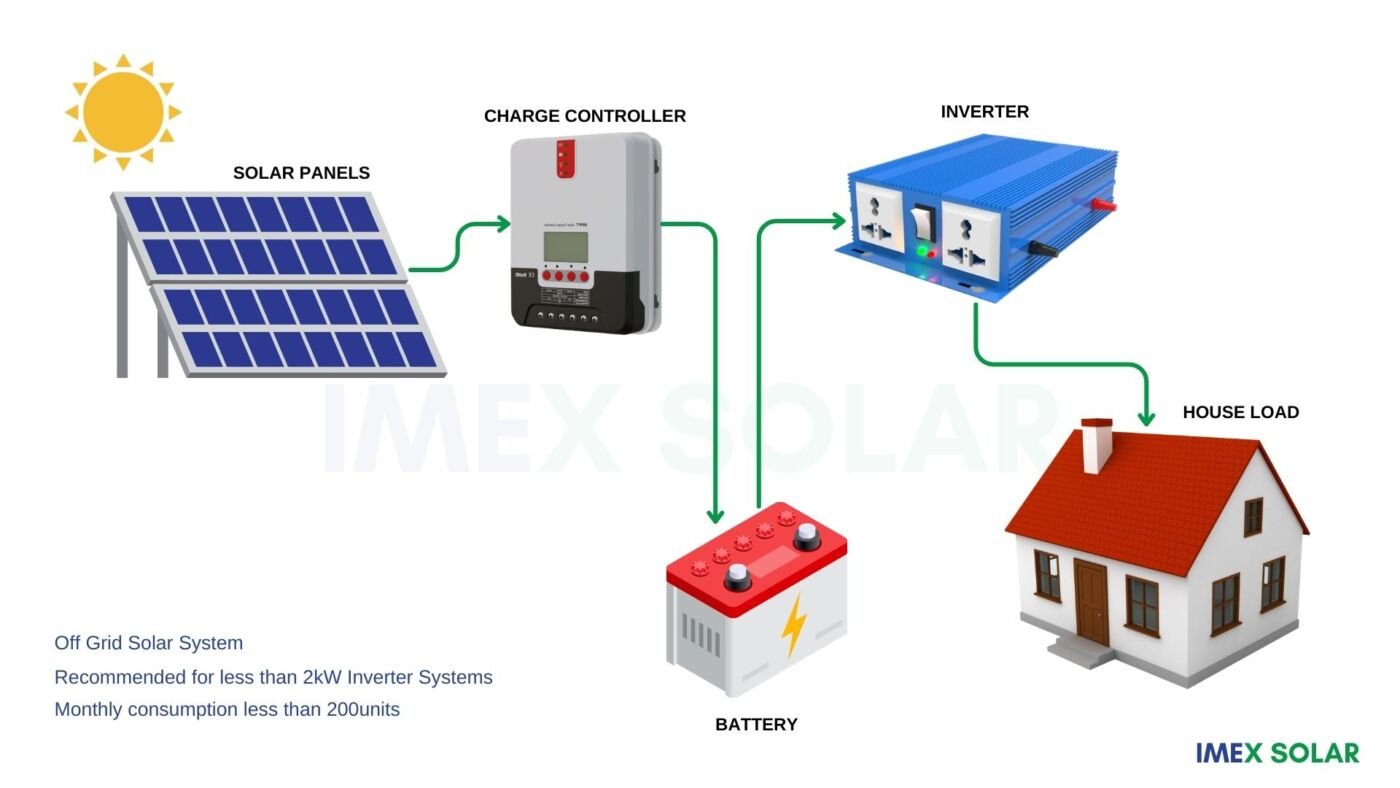

An off-grid solar system generates electricity through solar panels. The electricity is then sent to a charge controller, which regulates the amount of energy being stored in the batteries. The inverter converts the DC electricity from the batteries into AC electricity that can be used to power a home or business. When the batteries are fully charged, any excess energy can be used to power appliances or stored for later use.
Nowadays more advanced hybrid off grid solar PV systems are available in the market, where they use all in one hybrid off grid inverters, which combine and feed the load using solar, grid and battery power sources simultaneously in hybrid mode.
Main advantages of off grid solar system are, they ensure power reliability while reducing electricity bill and dependency on utility grid supply. Keep in mind in comparison, off grid solar systems initial cost is high and regular maintenance is required.
On Grid Hybrid Solar PV Systems
An on-grid hybrid solar PV system is a solar power system that is connected to both the utility grid and a battery backup system. These systems combine the functionality of both on grid and off grid solar systems.
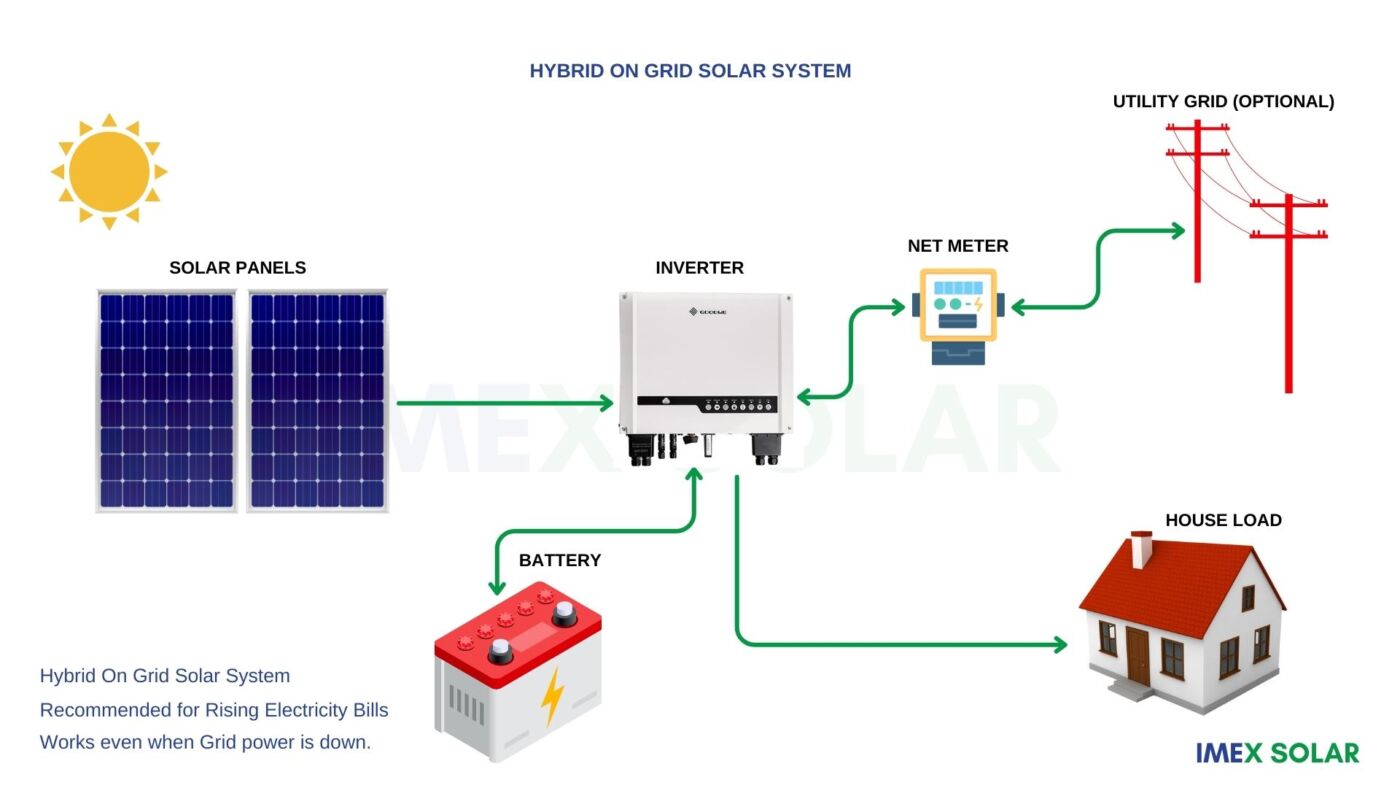
An on-grid hybrid solar PV system generates electricity through solar panels. The electricity is then sent to an inverter, which converts the DC electricity from the panels into AC electricity that can be used to power a home or business. The excess energy is then sent back to the utility grid, where it can be used by other customers.
When there is a power outage, the battery backup system kicks in to provide electricity. This ensures that critical consumer loads continue to operate.
On grid hybrid PV systems offer peace of mind to customer, reducing electricity cost and power reliability, but in compared to traditional on grid and off grid solar systems, hybrid on grid PV systems carry the most expensive price tags.
Components of a Solar PV System
Solar Panels: The Building Blocks of Solar PV Systems
Solar panels are the most critical component of a solar PV system. They are responsible for converting sunlight into electricity through the photovoltaic effect. A solar panel is essentially a collection of solar cells that are connected to form a module. When the sun’s rays hit the panels, they create an electrical charge that can be used to power your home or business. The more panels you have, the more electricity you can generate.
How Solar Panels Work?
Solar panels work by harnessing the energy from sunlight to create a flow of electrons that can be used to generate electricity. The process begins when photons from the sun strike the surface of the solar cells. These photons are absorbed by the semiconductor material in the cells, causing electrons to be released. The flow of electrons creates a direct current (DC) that can be used to power electrical devices or stored in batteries for later use.
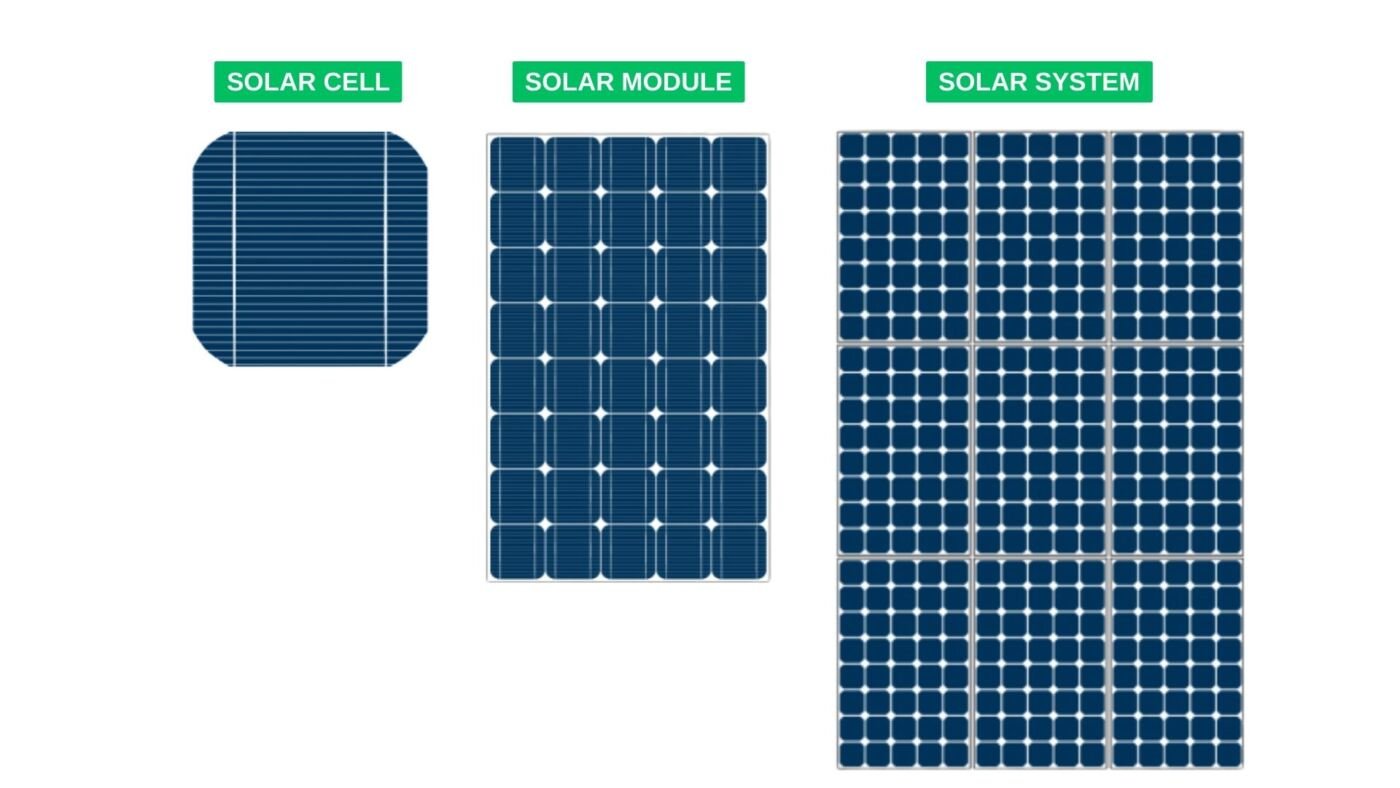
Types of Solar Panels
There are three main types of solar panels:
Monocrystalline: These are the most efficient and expensive type of solar panel. They are made from a single crystal of silicon and have a uniform black color.
Polycrystalline: These solar panels are less efficient than monocrystalline panels but are more affordable. They are made from multiple silicon crystals and have a blueish hue.
Thin film: These solar panels are the least efficient but are the most affordable. They are made from a thin layer of photovoltaic material and can be easily integrated into roofing materials.

Inverters
An inverter is an essential component of a solar PV system that converts DC electricity generated by solar panels into AC (alternating current) electricity suitable for use in homes and businesses. Inverters are available in different types based on application and operating principles.
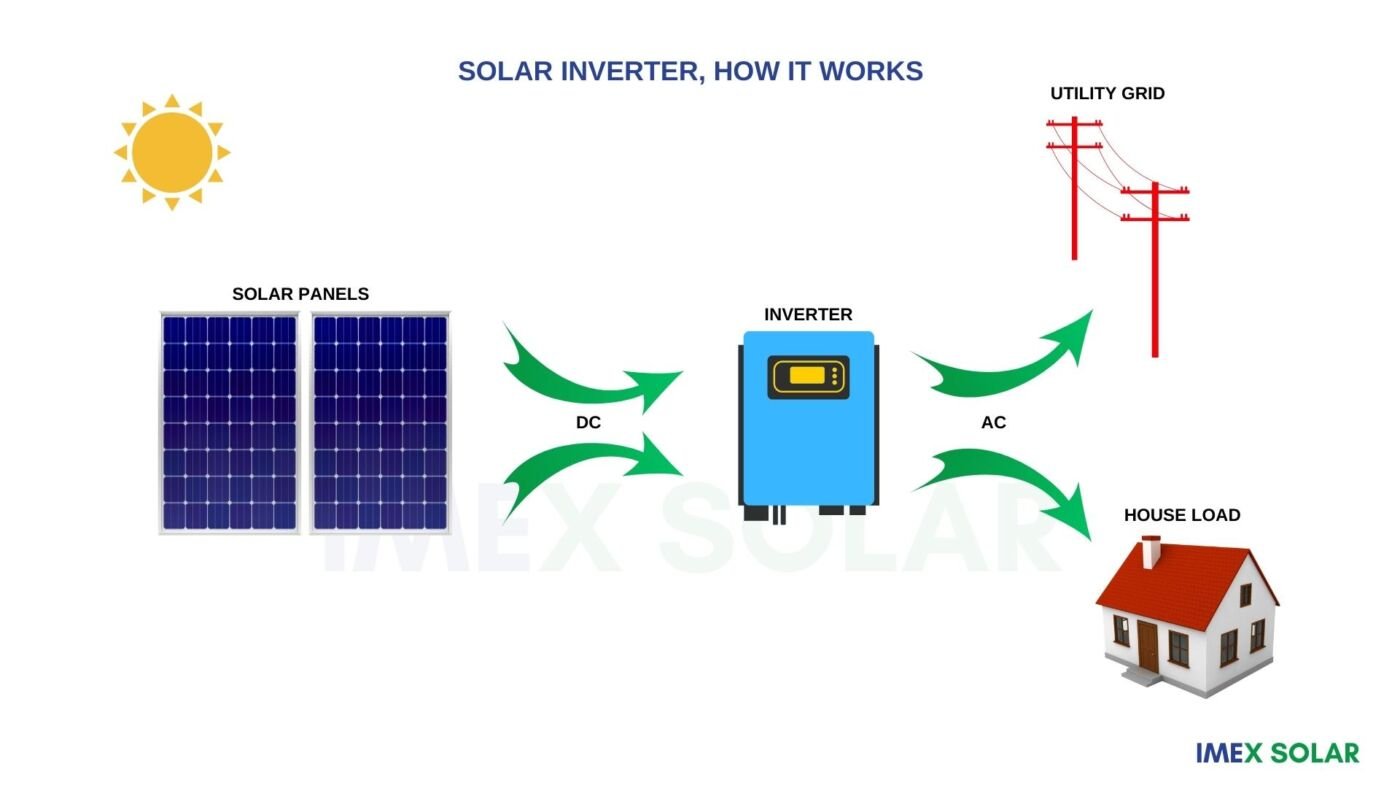
How Inverters work
Inverters work by converting the DC electricity generated by solar panels into AC electricity, which is used to power homes, businesses, and communities. The process begins when the DC electricity is fed into the inverter, which then uses a transformer to convert it into AC electricity at the desired voltage and frequency. The AC electricity is then fed into the electrical grid or used to power electrical devices directly.
With a technology advancements additional functions are integrated to inverter, such as battery charging from grid or solar, grid import and export, protective functions, and communication capabilities.
Types of Inverters
Based on Application, there are 3 main types of inverters: on grid, off grid and hybrid on grid inverters. Suitable inverter should be selected considering application requirements of needs such as grid stability, ROI, power reliability, budget and load profile etc.
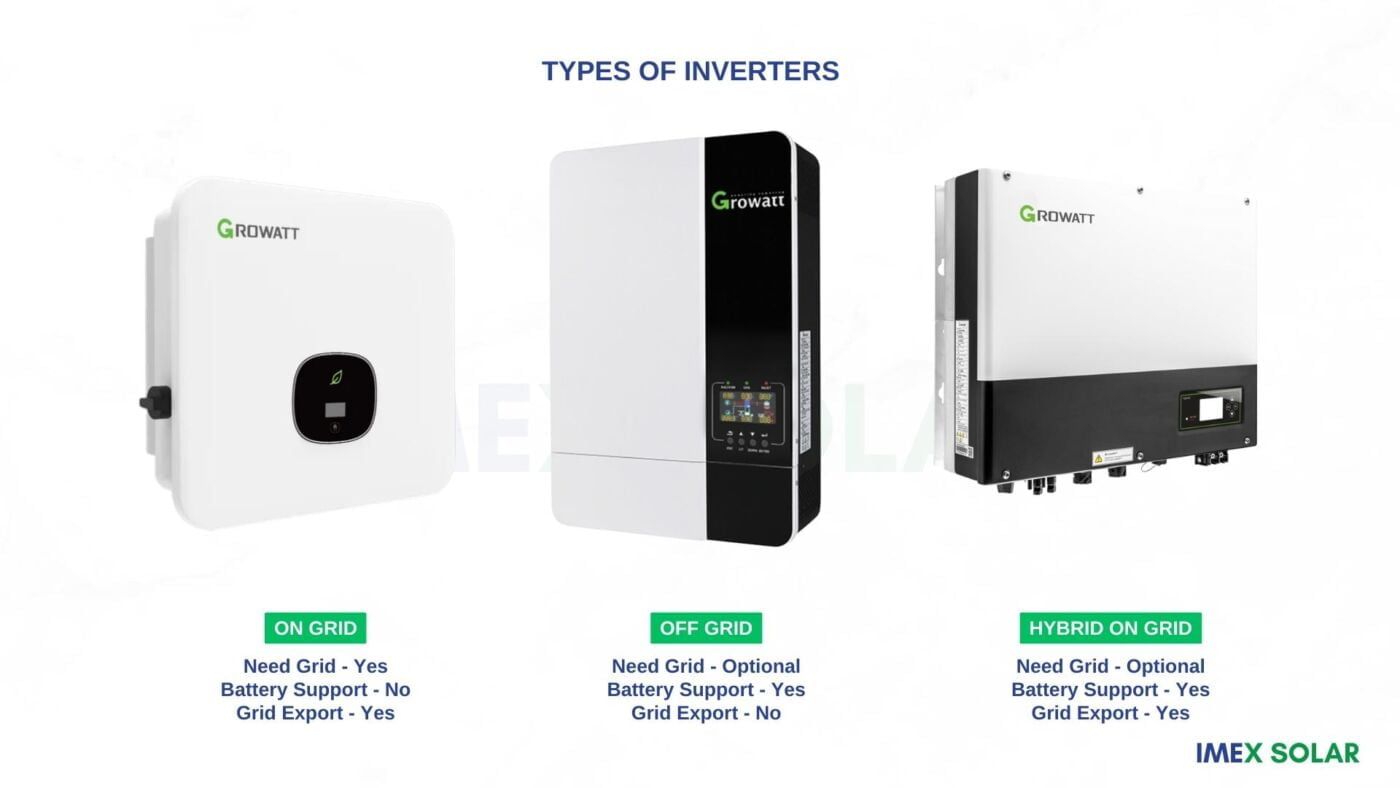
On Grid Solar PV Inverters
On Grid Solar Inverters are used in grid tied solar PV systems, to function they must be connected to the grid supply. They monitor grid health, synchronize with grid and export excess solar energy generated as AC power to the utility grid.
On grid inverters go to standby mode during power outages or low sunlight conditions and these do not support battery connections.
There are three main types of on grid solar inverters:
String Inverters: These are the most common type of inverter and are suitable for most residential and commercial installations. Multiple solar panels are connected in series to form a string and one or multiple strings are finally connected to the inverter.
Microinverters: These inverters are installed on each individual solar panel and are ideal for installations with shading or complex roof designs.
Power Optimizers: These devices are installed on each solar panel and work with a central inverter. They are ideal for installations with shading or multiple roof planes.
Off Grid Solar PV Inverters
Unlike grid-tied inverters, which convert DC electricity into AC electricity for use in your home or business, off-grid inverters must also be able to manage the charging and discharging of batteries.
Off-grid solar inverters are available in three types: pure sine wave, modified sine wave, and square wave. Pure sine wave inverters are the most expensive but provide the highest quality AC output, making them ideal for sensitive electronics such as computers and medical equipment. Modified sine wave inverters are less expensive but can cause problems with some electronics and appliances, such as motors and fluorescent lights. Square wave inverters are the cheapest but produce a low-quality AC output and are not recommended for most applications.
Off grid hybrid inverters are the latest model they are programmable to work according to consumer requirement. They can charge batteries, feed the load simultaneously and switch between grid, solar and battery sources automatically based on configured settings.
On Grid Hybrid Solar PV Inverters
Hybrid on-grid inverters is a versatile and efficient solution for homeowners and businesses looking to maximize their use of solar power and minimize their reliance on the grid.
What makes a hybrid on-grid inverter “hybrid” is its ability to work in conjunction with a battery storage system. This means that it can charge, and discharge batteries as needed to store excess solar energy generated during the day for use during the night or when the sun is not shining.
Additionally, a hybrid on-grid inverter can also work in tandem with the electricity grid. When the solar panels are not generating enough electricity, the inverter can supplement the power from the grid. Conversely, when the solar panels are generating more electricity than needed, the excess power can be fed back into the grid, potentially earning the system owner a credit or payment from the utility company.
Benefits of Using Solar PV Systems
Investing in solar PV systems can provide several benefits, including:
- Cost Savings
One of the most significant benefits of using solar PV systems is the cost savings they can provide. Once you install a solar panel system, you can generate your electricity, which can save you money on energy bills. Additionally, if you produce more energy than you need, you can sell the excess back to the grid and earn money.
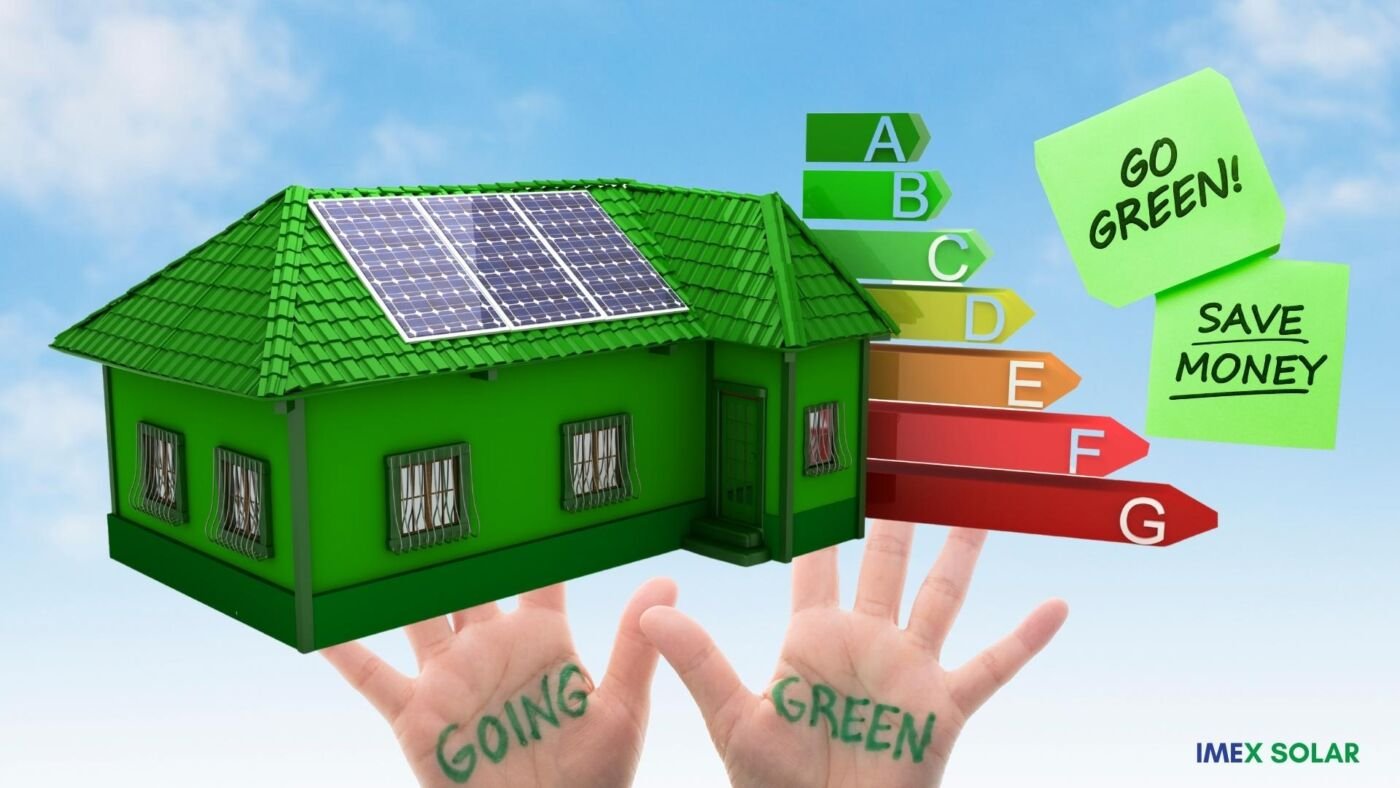
- Increased Home Value
Investing in solar PV systems can also increase the value of your home. According to a study conducted by the National Renewable Energy Laboratory, homes with solar panels sell faster and for more money than those without. The study found that homes with solar panels sold for approximately 4% more than homes without, indicating that solar panels are an attractive feature for potential buyers.
- Energy Independence
Solar PV systems can provide energy independence, which means you are not reliant on the grid for your electricity needs. This can be particularly beneficial during power outages or other emergencies when the grid may be down. With solar PV systems, you can generate your electricity, ensuring that you have power even when the grid is unavailable.
- Low Maintenance Costs
Solar PV systems have a relatively low maintenance cost compared to other types of energy systems. Once you install the system, it requires minimal maintenance, and the panels can last up to 25 years or more. The only maintenance required is periodic cleaning of the panels to ensure maximum efficiency.
- Reduced Carbon Footprint
Another advantage of solar PV systems is that they help reduce your carbon footprint. Solar panels do not produce any greenhouse gas emissions or pollutants, which means they are an environmentally friendly way to generate electricity. By using solar PV systems, you can reduce your dependence on traditional fossil fuels and contribute to a cleaner, more sustainable future.
Factors to Consider When Installing a Solar PV System
There are several things that must be taken into account before building a solar PV system, including:
- Energy Needs
The first factor to consider when installing a solar PV system is your energy needs. The size of the system you need will depend on how much energy you use and the type of appliances and devices you use. To determine your energy needs, you can review your electricity bills or use an online calculator to estimate your usage.
- Location
The location of your property is another critical factor to consider when installing a solar PV system. The amount of sunlight your panels receive will affect their efficiency, which means the location of your property will impact the effectiveness of the system. Properties with a south-facing roof or open space with minimal shading are ideal for solar PV systems.
- Roof Condition
Your roof’s condition is also an important consideration when installing a solar PV system. Your roof should be in good condition and able to support the weight of the solar panels. If your roof needs repair or replacement, it is best to address these issues before installing a solar PV system.
- Cost
The cost of a solar PV system is another important consideration. While solar PV systems can provide significant cost savings over time, the initial investment can be expensive. You should consider your budget and explore financing options, such as loans or lease agreements, to make the installation more affordable.
- Incentives and Rebates
Many government programs and incentives offer rebates and tax credits for installing solar PV systems. It is essential to research these programs and determine whether you are eligible for any incentives or rebates to offset the installation costs.
- Maintenance
Finally, you should consider the maintenance requirements of the solar PV system. While solar PV systems require minimal maintenance, you should still inspect and clean your panels regularly to ensure maximum efficiency. You should also consider any additional maintenance costs, such as battery replacements or inverter repairs, when budgeting for the system.
Maintenance and Care of Solar PV Systems
Investing in a solar PV system is a great way to generate clean energy and save money on your energy bills. However, like any other system, solar panels and inverters require regular maintenance to ensure that they continue to function efficiently and reliably. Proper maintenance can also extend the lifespan of your system and maximize its performance. In this article, we will discuss the basics of maintenance and care of solar PV systems.
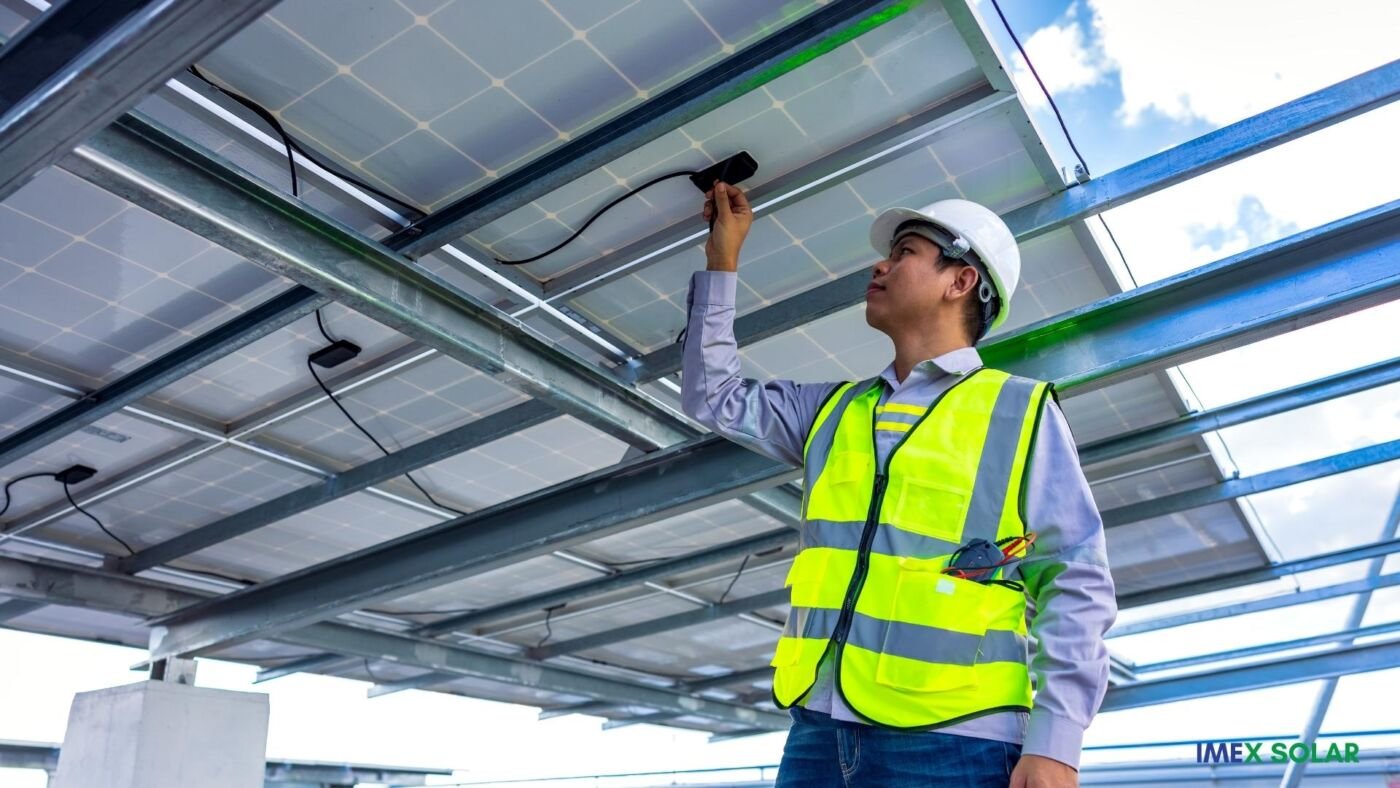
Maintenance and Care of Solar PV Systems
Investing in a solar PV system is a great way to generate clean energy and save money on your energy bills. However, like any other system, solar panels and inverters require regular maintenance to ensure that they continue to function efficiently and reliably. Proper maintenance can also extend the lifespan of your system and maximize its performance. In this article, we will discuss the basics of maintenance and care of solar PV systems.
Clean the Solar Panels Regularly
The solar panels that make up your PV system generate electricity by converting sunlight into energy. However, if the panels are covered with dirt, dust, or debris, they won’t be able to function at their maximum efficiency. To ensure that your solar panels are working at their best, you should clean them regularly. You can do this by using a soft-bristled brush or a squeegee to remove any dirt or debris from the surface of the panels. Avoid using abrasive materials or harsh chemicals, as they can damage the panels.
Check for Shade Obstructions
Even a small amount of shade can significantly reduce the output of your solar PV system. Therefore, it is essential to check for any shade obstructions around your system, such as overhanging branches or nearby buildings. If you notice any obstructions, you should trim the branches or remove the object that is causing the shade.
Inspect the Wiring and Connections
The wiring and connections in your solar PV system are crucial components that ensure that your system functions correctly. You should check these components periodically to make sure that they are securely fastened and free from any damage. If you notice any loose connections or damaged wiring, you should contact a professional to repair or replace the components.
Monitor the Inverter
The inverter is an essential component of your solar PV system that converts the DC power generated by the solar panels into AC power that can be used in your home. It is essential to monitor the inverter regularly to ensure that it is functioning correctly. You can do this by checking the display panel on the inverter or by using a monitoring app.
Schedule Professional Maintenance
While there are some maintenance tasks that you can do on your own, it is essential to schedule professional maintenance for your solar PV system periodically. A professional can inspect and service your system, identify any potential issues, and make necessary repairs. Additionally, many solar PV system warranties require professional maintenance to remain valid.
FAQs:
Q: How long do solar panels last?
A: Most solar panels come with a warranty of 25 years, but they can last much longer with proper care and maintenance. It’s not uncommon for solar panels to last for 30-40 years or more.
Q: How much does a solar PV system cost?
A: The cost of a solar PV system can vary depending on several factors, including the size of the system and the type of panels and inverters used. On average, a residential solar PV system can cost between 2,500USD and 8,000USD in Sri Lanka.
Q: What happens during a power outage with a solar PV system?
A: During a power outage, most solar PV systems will automatically shut off to prevent any electrical hazards to utility workers. However off grid and on hybrid solar systems continue to function with battery storage and provide power during an outage.
Q: How much electricity can a solar PV system generate?
A: The amount of electricity that a solar PV system can generate depends on several factors, including the size of the system, the location and orientation of the panels, and the amount of sunlight the panels receive. On average,
- 2kW solar PV system can generate around 200-240 per month.
- 3kW solar PV system can generate around 300-330kWh per month.
- 5kW solar PV system can generate around 500-550kWh per month.
Q: Can I install a solar PV system myself?
A: It’s not recommended to install a solar PV system yourself unless you have the proper training and expertise. Installing a solar PV system requires knowledge of electrical and roofing work and can be dangerous if not done properly. It’s important to work with a qualified and licensed installer to ensure that your system is installed safely and correctly.
Q: Do I need a battery with my solar PV system?
A: It depends on your energy needs and goals. If you want to have backup power during a blackout or want to store excess energy, then you will need a battery storage.
Q: Do solar PV systems work in cloudy weather?
While solar PV systems work best in direct sunlight, they can still generate electricity on cloudy or overcast days. However, the amount of electricity generated will be lower than on sunny days.
Q: What size solar PV system do I need for my home?
A: The size of the solar PV system you need for your home will depend on factors such as your energy usage, the size of your roof, and your budget. A reputable solar installer can help you determine the appropriate size of a solar PV system for your specific needs.
Q: How long does it take to install a solar PV system?
A: The installation time for a solar PV system can vary depending on the size of the system and the complexity of the installation. Generally, the installation process takes between one to three days.
Q: Can I sell excess electricity generated by my solar PV system back to the grid?
A: It is possible to sell excess electricity generated by a solar PV system back to the grid, depending on the policies of your utility company CEB/LECO. This is called net accounting and it can help offset the cost of your electricity bill.
Q: Are there any environmental benefits to using a solar PV system?
A: Yes, there are many environmental benefits to using a solar PV system. Solar PV systems produce clean, renewable energy and do not produce greenhouse gas emissions or other harmful pollutants.
Q: Can I finance the cost of installing a solar PV system?
A: Yes, there are many financing options available for installing a solar PV system, including loans, leases, and power purchase agreements (PPAs). It is important to research and compare different financing options to determine the best option for your specific needs.
Q: What happens to a solar PV system at the end of its lifespan?
A: At the end of its lifespan, a solar PV system can be recycled. The solar panels can be disassembled, and the materials can be reused, reducing waste and minimizing the environmental impact.
